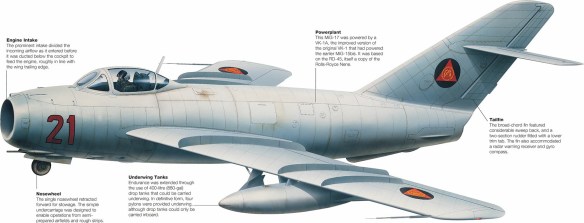This non-afterburning MiG-17 was flown by Lt Bomba of the Mozambique Air Force when he defected to South Africa in 1980, where the fighter was tested before being returned to Mozambique.
This MiG-17F wears the colourful markings of an aerobatic team provided by No.11 Squadron, Indonesian Air Force, that operated the type in the early 1960s.
In its day-fighter versions, the MiG-17 packed a punch with a nose armament of one 37mm (1.45in) N-37D cannon to starboard, and single 23mm (0.9in) NS-23 cannon on the port side.
Scourge of the U.S. air arms operating over Vietnam, the MiG-17 was a refinement of the Korean War-era MiG-15, rectifying the earlier fighter’s shortcomings. The result was an agile fighter and fighter-bomber that also gave good service in successive battles fought by Arab air forces against Israel into the 1970s.
Out-performed and with only very basic weapons and avionics, the MiG-17 should have been no match for the sophisticated American warplanes, led by the superb F-4 Phantom II that it encountered in the skies over Vietnam. However, in the hands of the North Vietnamese People’s Air Force, the MiG-17 (which received the Western codename ‘Fresco’) made full use of its excellent agility, diminutive size and hard-hitting cannon. Three North Vietnamese pilots attained ace status flying the MiG-17, led by Nguyen Van Bay with seven victories.
Mikoyan-Gurevich began work on the MiG-17 just as the MiG-15 was entering quantity production. The latter type would prove itself in the Korean War, but it suffered from some instability in the high-speed regime. The new fighter would be similar in appearance, but would importantly add aerodynamic refinements, primarily in the form of a wing of increased sweepback and reduced thickness: chord ratio. Indeed, in the early stages, the new aircraft was known by the designation MiG-15bis-45, on account of the 45 degrees of wing sweep. The result was a fighter with improved transonic performance. Armament remained unchanged from that of the MiG-15: one 37mm (1.45in) and two 23mm (0.9in) cannon in the nose, and initially at least, the Klimov VK-1 engine was retained as well. Design work was completed in spring 1949 and resulted in the prototype SI-2 that was first flown in January 1950. It soon displayed impressive performance, including a maximum speed of 1114km/h (692mph) in level flight.
The loss of the first flying prototype during a test flight delayed the programme by a year, but after completion of the state test flight programme using two new prototypes in June 1951, the new fighter was ordered into series production as the MiG-17 in September of the same year. However, with the MiG-15 already being built in large numbers, it was not until late 1953 that the type was adopted by the Soviet Air Force. Compared to the MiG-15, the new aircraft brought improvements in rate of climb, top speed and agility. When the U.S. Air Force encountered the MiG-17 over Vietnam, beginning in 1965, Robin Olds, commander of the 8th Tactical Fighter Wing, described the Soviet-designed fighter as ‘a very dangerous little animal. Its manoeuvrability is phenomenal!’
As production of the MiG-17 ramped up, the original VK-1 was replaced by the improved VK-1A that offered increased durability for the same thrust rating, and additional pylons (for a total of four) were added underwing to carry air-to-ground ordnance and drop tanks. MiG-17s eventually equipped over 40 air forces around the world, and production was also undertaken in Czechoslovakia, Poland and in China, where a range of variants were produced as the Shenyang J-5 series. In total, just short of 8000 MiG-17s were produced at five different factories in the USSR, and when foreign production is added to this number, the grand total exceeded 10,000.
Successive Improvements
The first major improvement to the MiG-17 line was manifest in the MiG-17F that added an afterburning engine, the VK-1F. First flown in September 1951, the MiG-17F began to replace the basic version in production in November 1952 and became the most important production version. The addition of an afterburner unit demanded some changes to the aircraft, which included a cut-back rear fuselage, a ventral strake below the rear fuselage and redesigned airbrakes.
A first radar-equipped interceptor version, the MiG-17P began testing in summer 1951 and became the radar fighter to serve with the Soviet Union, serving in small numbers from winter 1953–54. While the scanning radar was mounted in a radome above the intake lip, the tracking radar was contained in a fairing within the centre of the intake. The definitive radar-equipped model was the MiG-17PF, which combined the radar nose with the afterburning VK-1F. Indeed, the addition of an afterburning engine had originally been planned as a means of improving the otherwise diminished performance of the radar-equipped version of the fighter. The MiG-17PF succeeded the MiG-17P in production in late 1953, and was ultimately equipped with the RP-5 Izumrud radar with a range of 12km (7.5 miles) against a bomber-size target. With the addition of missile armament matched to RP-1U radar, the interceptor became the MiG-17PFU, built in small numbers in 1955. As such, the MiG-17PFU, with its armament of four RS-2US (AA-1 ‘Alkali’) beam-riding air-to-air missiles was the first missile-armed interceptor to enter production in Europe.
